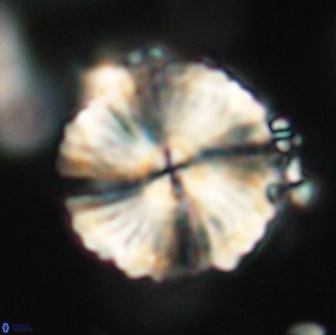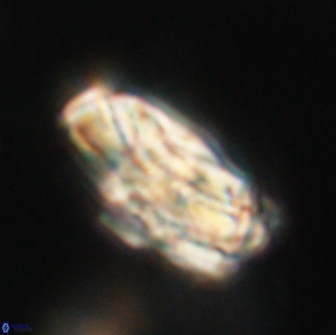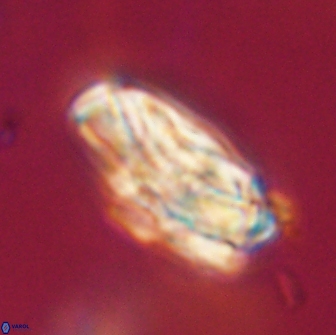Heliolithus magnificus
Set number: 2435
-
1
-
2
-
3
-
4
-
5
-
6
-
7
-
8
-
9
-
10
-
11
-
12
-
13
-
14
10µm
Holotype in the mobile mount
Set number: 2436
-
1
-
2
-
3
-
4
-
5
-
6
-
7
-
8
-
9
-
10
-
11
-
12
-
13
-
14
-
15
-
16
-
17
-
18
-
19
-
20
10µm
In the mobile mount
Set number: 2437
-
1
-
2
-
3
-
4
-
5
-
6
-
7
-
8
-
9
-
10
-
11
-
12
-
13
-
14
-
15
-
16
-
17
-
18
-
19
-
20
-
21
-
22
-
23
-
24
-
25
-
26
-
27
-
28
10µm
Heliolithus magnificus Bowman & Varol, 2021
A large circular species of Heliolithus has a wide disc and a very low and wide column (i.e. disc is only slightly wider than the column, but rarely almost equal), producing a squashed appearance in the side-view. The central canal is surrounded by a plug/tube cycle. The disc and column appear of similar height, and the column does not extend above the height of the disc (i.e. lacks free length). The column seems to have settled into the disc's depression. The entire species is birefringent in side-view and plan-view.
From Latin magnificus, meaning splendid – describing the grand or magnificent overall appearance of the species.
Overall height: 4.52μm; Column height: 1.00μm, Column diameter: 8.36μm; Disc diameter: 10.32μm; Collar diameter: 2.57μm.
Large to very large (10.0–13.0μm) circular species of Heliolithus comprised of birefringent disc and column. The diameter of the relatively flat or slightly concave disc is marginally greater than the diameter of the column or almost equal. The very low column does not extend above the disc (i.e. lacks free length) or rarely rises only slightly above the disc, generating a compact or squashed-like appearance. The height of the disc generally appears greater than the height of the column. The column and disc display a moderately wide central canal surrounded by a prominent plug/tube cycle, and distinct depressions are present at both ends of the canal (e.g. distal and proximal). The disc and column are constructed of a similar number of segments (about 36–46), and these relatively narrow segments are of equal width.
The dextrogyre extinction lines represent on the distal side (e.g. Pl. 46, figs. 3, 7), whereas the laevogyre extinction lines characterize the proximal side (e.g. Pl. 46, figs. 4, 8). When observed through a gypsum plate, the horizontal axis and blue region are aligned on the distal side, and the vertical axis and blue region are affiliated on the proximal side. The disc and column are birefringent in side-view and plan-view. The disc and column exhibit whiteish-yellowish birefringence color in plan-view, whereas the reddish-yellowish birefringence color depicts the disc and column in the side-view.
Heliolithus magnificus demonstrates some variation in overall size and within the size relationship (e.g. width/height ratio) of the disc and column. In plan view, this species differs from those of Caycedoa by the diagnostic birefringent pattern of its disc. The disc is non-birefringent in plan view in the species Caycedoa. Heliolithus magnificus has a disc that is slightly wider than the column (e.g. almost equal width). The column is confined within the height of the disc (e.g. lacks free length), and both disc and column are occupied by a central canal and plug/tube cycle. The column and disc are of similar height. Other species of Heliolithus may be differentiated from Heliolithus magnificus based on the following: Heliolithus bukryi has a hollow column that appears comparably higher, a distinct plug/tube cycle closing the central canal and a disc that displays pointed ends in side-view. Heliolithus iptamenosdiskos exhibits a disc that is only slightly wider than the column (e.g. almost equal width), a smooth plug/tube cycle and a disc that demonstrates rounded ends in side-view. Heliolithus knoxii, in contrast, possesses a much higher column that is occupied by a very narrow central canal and an indistinct plug/tube cycle. Heliolithus nefroeidis displays a kidney-shaped column that contains a narrow central canal. Heliolithus kolovos has a truncated/ wedge-shaped column that is confined to the height of the disc (e.g. lacks free length). In plan view, Heliolithus magnificus falsely resembles Heliotrochus kleinpellii (i.e., the double-disc form); however, careful focusing allows these individual species to be easily distinguished.
Bowman, A. R. & Varol, O. 2021. A Taxonomic Revision of Heliolithaceae - Applications in Resolving the Problematic Calcareous Nannofossil Biostratigraphy of the Paleocene. In: M. Montenary, M. (Ed.). Calcareous nannofossil biostratigraphy of the Stratigraphy and timescales. 6: 43-223.



